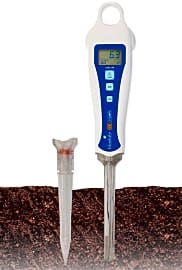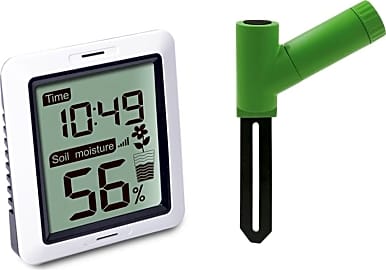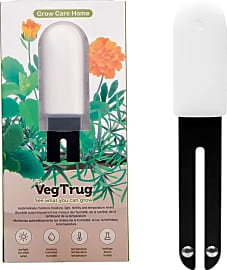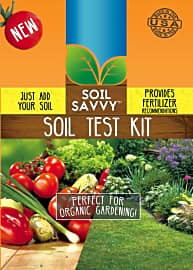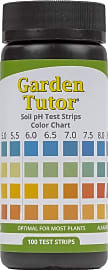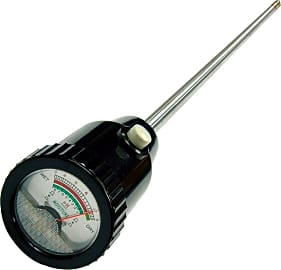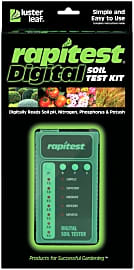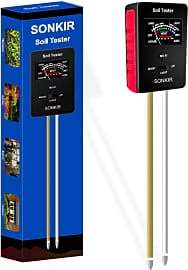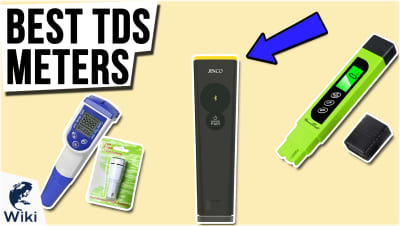The 10 Best Soil Testers

This wiki has been updated 35 times since it was first published in March of 2017. Keeping your lawn green and your flower beds lush can be hard, especially if the earth is not in the best shape. Over time, soil can become too acidic, alkaline, wet or dry, and all are bad news for grass, plants, and vegetables. With one of these testers, though, you can quickly find out exactly where you stand, so you can put together a plan of action to get things back on track. When users buy our independently chosen editorial recommendations, we may earn commissions to help fund the Wiki.
Editor's Notes
September 24, 2020:
It was a fairly busy round of updates. On top of removing the Kelway pHD, LinTimes 3-in-1 and Xlux Indoor/Outdoor, all due to availability issues, we also removed some low-end models with questionable accuracies – like the Luster Leaf 1880 – in order to make room for some top-end options that provide a bit more convenience and/or precision.
Some of our new additions this time around include the Kelway Meter — a portable unit that boasts better accuracy than many; the Ecowitt WHO291 — which comes with a handy remote monitor with a transmission range of up to 300 feet; and the VegTrug Smart Plant Monitor — a model with Bluetooth connectivity that not only measures soil moisture and nutrient content, but also tracks ambient temperature and light levels.
A few things to think about for this category:
Functionality: What are you looking to test? While basic models may only have a single test function – like the Garden Tutor Test Strips, which only measure pH, or the Ecowitt WHO291, which only measures moisture – other options are more versatile. The Gain Express and Kelway Meter can measure both moisture and acidity, as can the Sonkir MS-X1, which also features an integrated light meter. If you’re interestested in measuring nutrient content, an option like the VegTrug Smart Plant Monitor might appeal to you – as it features a built-in TDS meter – or you may be interested in an option like the Environmental Concepts Professional or Luster Leaf 1605, which use reagent testing to assess soil.
Power Source: With models like the VegTrug Smart Plant Monitor boasting battery lives of up to a year, this may not be the ultimate consideration to hang this purchase decision on, but with several battery-free options available on the market – including the Sonkir MS-X1, Gain Express and Garden Tutor Test Strips – it may also be a convenience worth looking for. Even the Kelway Meter, which boasts a .2-pH-tolerance for error, is a battery-free model.
Longevity: Even if they aren't limited by battery life, some of the selections we’ve ranked here will have their longevity restricted to a finite number of tests. While instruments like the Sonkir MS-X1 and Gain Express can be used again and again, until the end of the devices life, reagent-based models like the Luster Leaf 1605 and Environmental Concepts Professional only come with enough chemicals to conduct a specified number of tests. The Soil Savvy is a mailaway model that offers you lab-grade results, but only for a single test. The Kelway Meter can be used for an indeterminate amount of tests, but you will need to purchase new conditioning film from time to time, to help with maintenance.
May 10, 2019:
Soil Savvy is the most exact option on this list, as it subjects your dirt to expert analysis in a professional lab. It's a kit that's worth using every year, even in conjunction with other options listed here. It's not ideal for snapshots of your ground's health, but it can give you a bird's-eye view of how successful your dirt rehabilitation efforts have been year over year.
The Sonkir MS02, on the other hand, is perfect for carrying with you every day as you putter around the garden. It's quick, reliable, and cheap, giving you most of the information you need in just a few seconds. Consider pairing it with the Soil Savvy to cover all your bases.
We almost didn't include the Kelway pHD in this edition, as it's a relatively expensive single-function model. However, mismanaged pH levels can wreak havoc on your lawn, so it's worth plunking down a few extra bucks for a device that will give you the most reliable readings possible. Again, though, don't expect it to provide you with all the data you'll need to make informed choices about your lawn care.
Special Honors
MicroBiometer 10 Test Starter Kit This kit includes extraction vials, reaction agents, and anything else you might need to reveal the secrets hidden in your soil. Best of all, the whole process only takes about 20 minutes. microbiometer.com
Harris Seeds Professional You can enjoy the accuracy of a professional lab without the waiting time or postage fees, thanks to this kit. It allows you to run as many as three tests simultaneously, and checks on everything from phosphorous to potassium levels. harrisseeds.com
A Brief History Of Soil Testing
This involved checking out samples of dirt and measuring their levels of key nutrients, such as phosphorous and potassium.
Ever since the Agricultural Revolution, humans have been obsessed with getting more production from their land. For most of recorded history, this meant rotating crops, slashing and burning fields, and adding compost or other fertilizers to the dirt and then hoping for the best.
About midway through the 19th century, however, scientists began to develop ways to analyze soil's potential before attempting to plant crops. This involved checking out samples of dirt and measuring their levels of key nutrients, such as phosphorous and potassium.
This new research coincided with the discovery and development of commercial fertilizers, led primarily by the work of German chemist Justus von Liebig. For the first time, scientists were learning exactly what nutrients were essential for plant growth, as well as how to ensure that those nutrients were properly absorbed.
The establishment of the Department of Agriculture in 1862, as well as the passage of the Morrill Act that same year, made the study of plant growth a priority in the United States. As a result, by the early 20th century, many newly-formed land grant universities picked up the soil testing mantle.
After the Dust Bowl ravaged American agriculture, the desire for improved crop fertility boomed. By the time the 1940s rolled around, there was enough understanding of the chemical processes that were essential to healthy plant life that yields took off, thanks in large part to improved commercial fertilizers and technologically-advanced farming equipment.
Today, farmers still bag up their soil and ship it off to the nearest agriculture college for study. However, there are also plenty of excellent soil testers available to gardeners and amateur green thumbs, and you can easily find kits that are able to provide all the information a home-based grower would ever need.
There's no telling what the future will hold for soil science, but many experts believe that the next breakthrough is right around the corner. Regardless, though, one thing remains certain: you won't be able to grow much of anything if you have bad dirt.
How To Get The Most Out Of Your Soil Tester
So, you've listened to the experts — whether those experts are professional landscapers or just the guy on your block with the lushest lawn — and you've gone out and bought yourself a soil tester.
Now what?
Well, before you even get started, you should know that this isn't a one-shot deal. To get the best results, you should test regularly, and in multiple areas, so that you build up a useful sample size. It's also important to track your results, as their change over time can give you important information about what's working — or not.
This means rinsing it off with distilled water and wiping it with a clean cloth after a test.
Make sure that your tester is clean every time you use it, as well. This means rinsing it off with distilled water and wiping it with a clean cloth after a test. Don't use tap water, as that can throw of the pH balance, and be sure you've completely removed any remnants of previous samples before testing, as that can also skew your results.
You'll want to dig down to root level to grab about a half inch of soil from each spot you want to test, then throw all of the samples in a large bucket to mix them. Wait for them to dry, as moisture can affect the readings (noticing a pattern yet?), and then use your tester as directed.
Write down all of the relevant information on a pad or in a journal, and keep the numbers in a safe place. You'll want to reference them the next time you test, which should be a little while after you take whatever corrective action your current readings suggest.
If everything goes well, you should see your numbers trend in a positive direction. Of course, if everything's going really well, you shouldn't need any numbers to spot the difference — it should be right there in front of your nose.
How To Fix Your Soil
If you find that your earth isn't up to snuff, fear not — there are ways to quickly fix it so that it becomes the equal of even the fanciest, most sophisticated dirt on the planet.
There are two main problems that most people will experience with their soil: either it's too acidic or too alkaline. This is determined by your pH levels, as anything below seven is considered acidic, and anything above is alkaline. Thus, your sweet spot is right in that neutral area around lucky number seven.
It can severely restrict a plant's ability to absorb nutrients, so if your green friends are withering away despite your best efforts, this could be why.
Acidic soil tends to be found in areas with lots of rainfall, and it's a breeding ground for weeds, but not for grass or veggies. You need something to cut the acidity, while also adding calcium and magnesium back into the soil. Limestone is usually just what the doctor ordered, as it's full of nutrients and does a great job balancing out acid levels.
Alkaline dirt, on the other hand, is common in dry areas. It can severely restrict a plant's ability to absorb nutrients, so if your green friends are withering away despite your best efforts, this could be why. Conditioners like gypsum or sulfur are generally recommended, or you could boost acid levels with peat moss or organic compost.
If you're trying to fix a large swath of vegetation — like, say, your entire lawn — then you'll probably need to rely on massive amounts of fertilizer. However, if you're only trying to boost the productivity of a small flower or vegetable garden, you may be able to build raised plant beds that you can fill with custom-blended soil, allowing you to skip a lot of the dirty work.
No matter what you're trying to grow, though, you'll need to make sure that your land can support it. Otherwise, you're wasting your time and throwing your money away — and nobody wants to hear a sob story about how you went broke investing in dirt.



